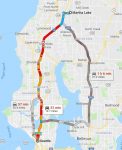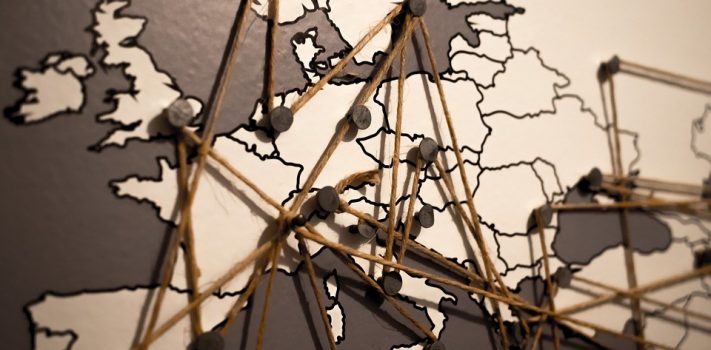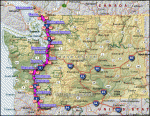Editor’s Introductory Note: This article on Intelligence first appeared at the excellent American Partisan web site, and is re-posted with permission. Part 2 will be posted on Saturday, February 2, 2019.
I recommend American Partisan as “must reading.” Consider bookmarking it.
—
Part I: Understanding Your AO
There’s a disconnect among many in the prepper community between information and intelligence. In recent years, a disturbing notion has become fashionable; namely, that in order to effectively operate in your area — whether it be due to a societal meltdown of some type or a natural disaster — you need a big map, some brightly colored pins, and a whole bunch of data. Unfortunately, it’s not actually that way, and a lot of people are deluded into thinking it is. Perhaps even more important is understanding that sometimes it’s a lot more simple than that.
This series will look at some of the things that are widely believed in the various prepper, patriot, and other communities about intelligence, terminology, and capability — when these things are even addressed at all. We’re going to talk real world scenarios, real facts, and real situational awareness. Today we’ll talk about your Area of Operations (AO).
What is Your Area?
Terms like “area of operations” and “area of influence” are often improperly defined, offering people a twisted and even overambitious view of what their own capability is. Your area of operations is not your state. If you live in Washington, it’s not the I-5 corridor or the “Northern Cascade region.” If you’re in Florida, it’s not the panhandle, and if you’re in New York City it’s not your borough. In fact, if you live in an urban area, it’s not your city at all, and may not even be as large as your neighborhood. Understanding what your actual AO is and how it fits into a bigger area is critical to understanding what you and your group are capable of affecting.
Let’s look at a typical fire department, for instance. A standard fire department has a district it responds within, and its personnel are limited to operating within that particular district except in cases where they’ve been formally invited or requested, such as in a rural area where a neighboring district has a big fire and needs help. The lines of a department’s district are set in stone; if a fire occurs literally across the street from the boundary, it is not that district’s responsibility, although they will want to be informed about it in case it crosses over into their AO.
Within that department are multiple crews, trucks, and tools, stationed at multiple halls. Those halls also have smaller, more focused areas of response. The district may be split into parts based on geographical boundaries, population density, or other criteria. A specific hall and the people within it are given the responsibility of handling that area. If a call goes out and it originates in that hall’s AO, they respond. They would not, however, typically respond to an incident that’s across town, even though it’s within their greater departmental district, unless they’re asked to do so — and even then they are not considered the primary crew on the incident. Why? Because they cannot get there in time to do so. It’s that simple. I would also add that you don’t see all the members of a given area interfacing with all the members on a neighboring crew in an incident. That’s why there are liaisons and chiefs and captains and whatnot…but that’s a whole other topic.
That brings me to the first concept you need to understand about how to decide on your AO as a civilian prepper. There’s a simple rule I use: If you are not close enough to be the primary responder on a house fire in a given area, then it is not part of your AO. Why do I use this statement? There are several reasons but let’s start with two big ones.
- A house fire is about as “emergency” as it gets. Property, preps, life and limb are all in danger. If there’s ever a situation in which you’re going to move your rear end at top speed, it’s going to be that. Even if you’re not physically fighting the fire, you’d want to be there to help your group members in any way possible, right? You might help them protect outbuildings or other pieces of the property that might be in danger from the fire. You might help them get to a safe location. You might need to coordinate resources among your other group members to help take care of your affected member and his family.
- Being able to get to a location quickly and quietly if necessary is critical. If your response time to a given location can vary widely based upon traffic, weather conditions, or some other factor, then that location shouldn’t be in your AO because you cannot guarantee, even when it’s a life or death scenario, that you will be there in a timely manner.
You’ll see a lot of groups talk about their “AO,” but they’re referring to the area of woods in the middle of nowhere that they go to for their “training.” You know, the one they drive two hours to reach. That’s not their AO.
People want to believe — and want others to believe — that they can make a difference across a large area, that they “have people” everywhere who can step up from within their group. But let’s look at a real world example, using a real world area. The photo here is the I-5 corridor running through western Washington. Our example group (which is fictional but well-represented in that area) has members in Everett, Shoreline, Seattle, and even closer to Tacoma. From Everett to Tacoma is about 62 miles. Without knowing anything about the area, would you trust that your group members could make it 62 miles to you if they had to? Of course not. Are you in each other’s AO? No, and if you believe you are, you’re putting yourself and your group in a dangerous position.
 Now let’s add in some real-world knowledge. Here’s what traffic looks like along part of that route:
Now let’s add in some real-world knowledge. Here’s what traffic looks like along part of that route:
Look how long it’ll take you to drive from Martha Lake to Seattle. That’s a normal day’s worth of traffic; now add in the gridlock that would come from a natural disaster. Can you honestly get to your buddy down in Seattle? Or even Shoreline? No. No matter how “brotherly” you guys are, you cannot get to him if you need to, and he cannot get to you. For all emergency/prepping purposes, he is not in your group, and he’s not in your AO. In fact, even within any one of these cities, traffic at a given time might be too much for you to get from one end of town to the other in a timely manner. And let’s point out something else: Guess how many bridges are on that route? Now you have another problem.
You might be thinking that the whole house fire criteria is stupid because it basically puts you all the way down to maybe a block or two of your neighborhood. Are you aware of how small an area that is? you ask. Yes, I’m aware — and that’s why you should be working on your neighbors and figuring out who’s who and who you can trust. Because in a disaster of any kind, your neighbors are the ones you’ll have to rely on. Your buddy in Tacoma isn’t coming.
I Have a Smart AO. Now What?
Now you need to understand your area. “Oh but I do,” you say. “I know all about it. I have a map with all the strategic objectives and possible avenues of approach and and and….” That’s nice. What are you going to do with that information? What action is that data informing?
Having maps and pins and highlighters and overlays when you aren’t processing the “whys” and “what now?” of the information you’re collecting is basically like studying chess when you aren’t going to play. You watch the YouTube videos of grandmasters, you study their tactics, you understand the moves and how the game works and you can recite all kinds of statistics about chess…but you don’t play the game. You have no purpose for knowing all of this information. Therefore, you’ve just wasted a lot of time.
Some might argue that it’s good information to have if you ever need to use it. Again, that’s nice, but still worthless. Unless you plan to engage in some form of chess, you have no reason to learn all of that information — and all that data is just that.
You might counter that the information helps you meet your intelligence requirements, but the question then becomes what are your intelligence requirements meant to inform? What are you going to do once they’re fulfilled?
In the military, intelligence requirements are meant to answer the question, ultimately, of what do we do next/after that/after that? Understanding where the enemy is only means something if you’re going to act upon it. Let’s go back to our fire department example. What kinds of data could they be collecting and more importantly why?
- Construction projects in the area. (Used to create alternate routes to an incident.)
- Local events. (Used to plan for personnel coverage and possible staging.)
- the types of fires that happen in the area. (Used to determine what type of gear/apparatus they purchase use and respond with).
- Information on weather. (Used to inform and predict fire behavior, rural road conditions, etc.)
- Training level of personnel. (Used to plan training exercises, and even identify valuable and less critical personnel.)
- Natural and man-made water sources. (Used to plan where to fill trucks during a fire.)
Each one of these data points has a purpose, and the department in question can use that information right now, in a practical way. The raw information means nothing unless 1) it has a practical use and 2) it’s being processed into intelligence that can be applied to that use.
You might have a map with overlays for everything from traffic to water sources to where the local Walmart is, but unless you can answer the question, “What can I do with that information right now?” then you’re wasting your time.
Keep in mind that your plan also needs to actually have value. I know of a group who used maps to plan out where their local big box stores were at, along with avenues of approach to those stores. Their plan, in the case of some societal meltdown, was to head for these stores and use them as their base of operations because then “we won’t have to worry about supplies.” What might the problems be in this scenario?
- Everyone in the surrounding area will have a similar idea. Do you have enough people to outnumber everyone and their mother in the area?
- The store is 7 minutes away, by car, for the closest member on a good day with no traffic and clear weather.
- The group has 6 members.
- Two of the guys in the group are grossly overweight and out of shape.
All of the time spent looking at maps for where to go and how to get there won’t matter one iota if your vehicle is stuck in a gridlock, several feet of flood waters, or some other obstacle. It won’t mean anything if only 3 of your guys can get there and you’re confronted with about 1,000 other people who beat you to the store. And now you’re basically out of your own actual AO, without supplies because you bet on being able to take that store. By the way, your families are all at home, unprotected, in an area where you didn’t take the time to learn your own street and neighbors enough to know if they’re a threat because you were too busy training in distant woods and planning to take over Walmart in a disaster. What now?
Intelligence: Wrapping Up
It doesn’t matter how many maps you have, how many cute pins or markers or overlays or whatnot you’ve invested in if you’re looking for the wrong information, your plan is unworkable, or you think that raw information is enough to inform your plan. Understand what intelligence is and what it isn’t. Make a real, practical, workable plan about what you can do, today, on the street where you live. You don’t need maps and overlays to do that, and you don’t need a group that’s spread over a 40-mile stretch of area. You need a brain, effort, and an understanding of human nature. Start with that first.
—
Tomorrow we will present the concluding Part 2.












I like the topic but I disagree (respectfully) with many (not all) of the notions in the first part of this article. I think the author forgets that there is strategic intelligence and tactical intelligence. Mostly what she is talking about is tactical or actionable intelligence. The author uses the example of of a fire department but what we all need to know that while a fire department operates in the realm of tactical intelligence there is someone in that community looking at the bigger picture or strategic intelligence, that being the emergency operations center. If you are interested in the difference between tactical and strategic Intel go over to the “Forward Observer” website and look for an article entitled “Tactical, Operational, and Strategic Intelligence.” Don’t wait to discover a threat when it’s knocking on your AO. I am looking forward to the rest of the article to see if the bigger picture is addressed.
Thanks for clarifying the difference between information and intelligence. And linking up why you gather up this stuff in the first place to what are you going to do with it next.
Sometimes having an under-active imagination is an asset. Keep it real. Thanks Kit!
Kit’s point are well taken, but Area of Interest is the circle or sphere used to enclose where you gather information from.
In a sphere, you consider also anything undergound such as earthquake potential, and overhead with continuous coverage satellites when everything is photographed in fine detail continuously.
Intelligence isn’t just about your team, it’s also about knowing what capabilities of all other forces in the sphere: Anitfa, FBI, Sheriff, security, NOAA, public utility repair teams, telecoms, road crews, first responders, private groups, etc., that could influence situational outcomes.
Weather effects on terrain in the A of Interest are important, as wind storms cut power, fall trees across our roads, high wind waves shut down key floating bridges infrequently, wet and snowy roads cause collisions which shut down mountain passes and floods shut down I-5 at Chehalis, mud slides frequently shut down the passenger rail service in the Puget region, and not infrequently close off the sole highway resupply routes. All these are impacts which should be assessed and monitored, as they impact both your AO and Area of Influence, so are key information items.
God Bless
The term AO is typically shorthand for Area of Responsibility, which then makes the boundaries of a fire department or fire battalion or company within a department easier to understand.
Unless you plan to exercise control over a large swath of territory, like the State Guard or National Guard would, your AOR or AO is relatively small. Maybe just the local neighborhood. Your Area of Interest, OTOH, could be considerably larger, and might include neighboring towns and cities.
Always Out Front.
Thanks for posting this.
For some reason I can’t copy and paste them from her site.
But I can from here with no issues.
Their web site has DigiProve installed, “The Digiprove plugin will inhibit the common right-click and copy function available to users through their browsers, warn them about copying protected material, and send you an Email alert bearing the IP address of the user behind the copy attempt.”.
My AO is my line of sight. Not that I don’t want it to be larger or wouldn’t want to help my neighbors but I doubt I can do much outside if it, even with the whole team
Kit,
This is really a welcome and much needed look at AO.
Area of Responsibility (AOR), as referenced in comments above, is really irrelevant in the context of your excellent article, and the terms are not truly interchangeable. For example, the Tucson Sector of the Border Patrol extends from the AZ-NM state line, westward to the Yuma County line. No BP agent considers the entire sector to be their AOR. Much like your example of fire stations, BP agents work out of geographical areas that are much smaller in size. Thus, an agent assigned to the Three Points station may have an AOR that is 20X30 miles, versus several thousand square miles. For a BP agent, AO is really a tactical definition of an even smaller area where they routinely work. The key point of your article is that you have to know your AO and be able to respond to situations within that AO in a timely manner. If that turns out to be limited by your line of sight, so be it.